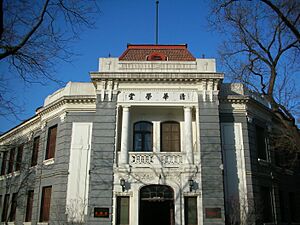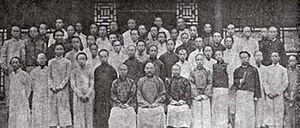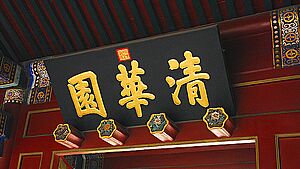History of Tsinghua University facts for kids
Tsinghua University is a famous school in Beijing, China. It was started in 1911. The university is built on the land of Tsinghua Garden. This garden used to be the home of Prince Yinzhi. He was a son of the Kangxi Emperor from the Qing dynasty.
In 1909, the United States decided to reduce a payment from China. This payment was part of the Boxer Protocol. The US government, led by Theodore Roosevelt, lowered the amount by about $10.8 million. The Chinese government used this money to create a special scholarship program. It was called the Boxer Indemnity Scholarship Program. They also started a school called the China Institute. This school was later renamed Tsinghua School. In 1925, it grew to include a college section.
Contents
How Tsinghua University Started
The story of Tsinghua University begins with the Boxer Protocol. This agreement was signed in 1901. China's Qing dynasty had to pay a large amount of money to several countries. This was because of the Boxer Rebellion. The United States was one of these countries.
The US was supposed to get over $24 million. But China had trouble paying this huge debt. So, China's foreign affairs office asked their ambassador, Liang Cheng, to talk with the US. Liang Cheng met with the US Secretary of State, John Hay. Hay suggested that the US payment was too high.
Later, US President Theodore Roosevelt agreed to lower the payment even more. The US would return the extra money to China. This money would be used for education. It would also help Chinese students study in the United States. To thank President Roosevelt, a gym on the Tsinghua campus was named the Roosevelt Memorial Gymnasium.
On July 11, 1908, the US ambassador, William Woodville Rockhill, told the Chinese government about this plan. Prince Qing of China was very happy. He said China would send students to American schools every year.
Tang Shaoyi then went to the US with an official letter from China. The letter promised to send many students. For the first four years, 100 students would go each year. After that, at least 50 students would go every year.
The US government started sending the money back in 1909. A person named Tenney Charles Daniel was put in charge of the study program. Students were chosen in June. The Chinese government approved the plan on July 10. The office for the program opened on July 17.
Zhou Ziqi and Tang Guo'an were chosen to run the office. The beautiful Tsinghua Garden was given to the program. This is where the new preparatory school was built.
Tsinghua in the Republic Era
In 1928, Tsinghua became a national university. This happened during the time of the Republic of China.
When the Second Sino-Japanese War began, things changed. Tsinghua University, along with Peking University and Nankai University, had to move. They went to Changsha and formed a new school. It was called the National Changsha Provisional University. In 1938, this combined school moved again to Kunming. There, it was renamed National Southwest Associated University.
Tsinghua University returned to Tsinghua Garden in 1946. After some changes in education rules in 1952, it became one of the most important universities in the People's Republic of China. Later, in 1956, some Tsinghua teachers moved to Taiwan. They started a new school called the National Tsing Hua University in Hsinchu.
Early Years of the People's Republic of China
In 1953, Tsinghua University started a new program. It was the first university to have "political counselors." These counselors were new graduates who were also members of the Communist Party. They helped manage students and student groups. This program later spread to other universities in China.
During the Cultural Revolution
During a time called the "Third Front" construction, Tsinghua opened a branch campus. This was in Mianyang, Sichuan province. This construction aimed to build up industry in China's inner regions.
Start of the Cultural Revolution
The high school connected to Tsinghua University became very important in the Cultural Revolution. This was a big movement in China. In the early 1960s, some students at the high school started talking about "class struggle."
In May 1966, some students put up a large poster. It said they wanted to join this "class struggle." The school leaders did not like this. On May 29, a small group of older students met. They decided to call themselves the "Red Guards." This meant they were "Mao Zedong's Red Guards." On June 2, they put up another poster. It said they would protect "Mao Zedong thought." Many students from other schools came to support them.
Between June and July 1966, the Tsinghua University High School put up three more big posters. These posters talked about a "revolutionary spirit of rebellion." The first two posters were shown to Chairman Mao Zedong. He supported them on August 1. These posters were even printed in major newspapers. Mao Zedong met with the Red Guards many times. This helped the Red Guard movement spread to many universities and people.
The Red Guards started campaigns to change old ideas and customs. On August 24, 1966, they pulled down the old secondary gate of the university. This showed they were against old ways. Later, a giant statue of Mao Zedong was put up in the same spot. This led to many similar statues being built across the country.
On June 8, 1966, a special group came to Tsinghua University. This group included Chinese President Liu Shaoqi and his wife Wang Guangmei. They criticized the school's principal and other leaders. They called them "capitalist roaders." Some students, like Kuai Dafu, did not agree with this group. Kuai Dafu said the group was not truly revolutionary. He was then held for 18 days. Many others were also criticized.
In July, Mao Zedong returned to Beijing. He did not agree with the special group and supported the students who resisted. Soon, posters criticizing Liu Shaoqi appeared at Tsinghua Garden.
On December 19, 1966, a large Red Guard group was formed at Tsinghua. It was called the "Tsinghua University Jinggangshan Corps." Their goal was to oppose Liu Shaoqi. Kuai Dafu became their leader.
On December 25, this group led a large protest against President Liu Shaoqi and Deng Xiaoping. This helped spread the Cultural Revolution throughout Beijing. On January 6, 1967, Kuai Dafu's group tricked Liu Shaoqi's wife, Wang Guangmei, and held her. On April 10, they held a big public meeting to criticize Wang Guangmei. Thousands of people joined this event.
By April 1967, the Jinggangshan Red Guards split into two groups. They disagreed on important issues about the Cultural Revolution. These two groups, the "headquarters" and the "414 faction," had many arguments. They both claimed to be the true revolutionaries. They argued about how to understand the Cultural Revolution and how to treat leaders.
In 1967, the Chinese government asked students to return to school. They wanted students to focus on "revolution in the classroom." But tensions between the two groups at Tsinghua grew again. This led to many small fights.
Between April and July 1968, the two Red Guard groups had very serious fights. These were called the "100-day clashes." Students used different items in these clashes. These fights caused many people to get hurt. Buildings were also damaged. In the end, one group was forced to give up.
On July 27, the Chinese government sent a large group of people to Tsinghua. This group was called the "Mao Zedong thought propaganda team." They wanted to stop the fighting. But some Red Guards fought against them. Several propaganda team members were killed or hurt. This event shocked Beijing.
The next day, Mao Zedong ordered an end to the fighting. He met with the Red Guard leaders, including Kuai Dafu. He told them to stop the clashes and welcome the propaganda team.
Later Cultural Revolution Years
In August 1968, the propaganda team started to "re-educate" the students. Many students were sent to work on farms and in factories in the countryside.
In 1969, the school built a farm in Nanchang County. Many staff members were sent there to work. Some people got sick with a disease called schistosomiasis. The university's medical team had to treat these patients for many years. One person said that working on the farm felt like a punishment for being a student.
Starting in 1970, Tsinghua began an "educational revolution." This was based on Mao Zedong thought. It lasted until the end of the Cultural Revolution. Here are some parts of this revolution:
- Workers were to lead all activities.
- Teachers were to be reformed but still do their jobs.
- The school was to do industrial work. Students and teachers had to help with factory production. This often stopped regular learning and research.
- Students who were workers, peasants, or soldiers were allowed to join the university.
- Old lessons and books were replaced with new ones.
- The school had to follow new teaching methods. This sometimes meant public criticism of people.
Between 1970 and 1975, Tsinghua University changed a lot. It planned to have three factories. It also had seven main study areas, like electrical engineering and chemical engineering. The school had two "branch campuses." One was in Mianyang, and the other was the farm in Jiangxi. Later, more campuses and facilities were opened. The school also started courses for workers and short-term training.
On June 27, 1970, Tsinghua started admitting students again after a four-year break. These were the "worker-peasant-soldier students." Mao Zedong wanted the education to be shorter, only three years. Students were chosen based on recommendations from their communities. After graduating, they went back to their old jobs. The last group of these students graduated in 1981.
From 1973 to 1976, during a campaign called "Criticize Lin, Criticize Confucius," groups at Tsinghua and Peking University wrote articles. They used a special pen name, "Liang Xiao." This name sounded like "two schools."
In 1975, Deng Xiaoping became more powerful in the government. Some leaders at Tsinghua wrote letters to Mao Zedong. They complained about the people who were really in charge of Tsinghua at the time. Mao saw this as going against the Cultural Revolution. He started criticizing these leaders and Deng Xiaoping. This led to a big debate about the "educational revolution." By December, it became a nationwide movement. Tsinghua University almost stopped its normal teaching. Instead, it focused on criticizing Deng Xiaoping. Many posters were put up, and one leader was criticized over 200 times.
On March 31, 1976, after Zhou Enlai died, a Tsinghua leader said no flowers should be sent to Tiananmen. But on April 3, some students sent white flowers to the Monument to the People's Heroes. This became part of the 1976 Tiananmen Incident. On April 6, the Tsinghua leader called this a "counterrevolutionary attack." This led to investigations and arrests of many people.
In October 1976, the "Gang of Four" leaders were removed from power. This marked the end of the Cultural Revolution. On October 16, efforts began to bring the university back to normal. The special "revolutionary committee" system was ended the next year.
Tsinghua in the 1990s
In the 1990s, Tsinghua joined special projects called Project 211 and Project 985. These projects aimed to make higher education in China even better.





